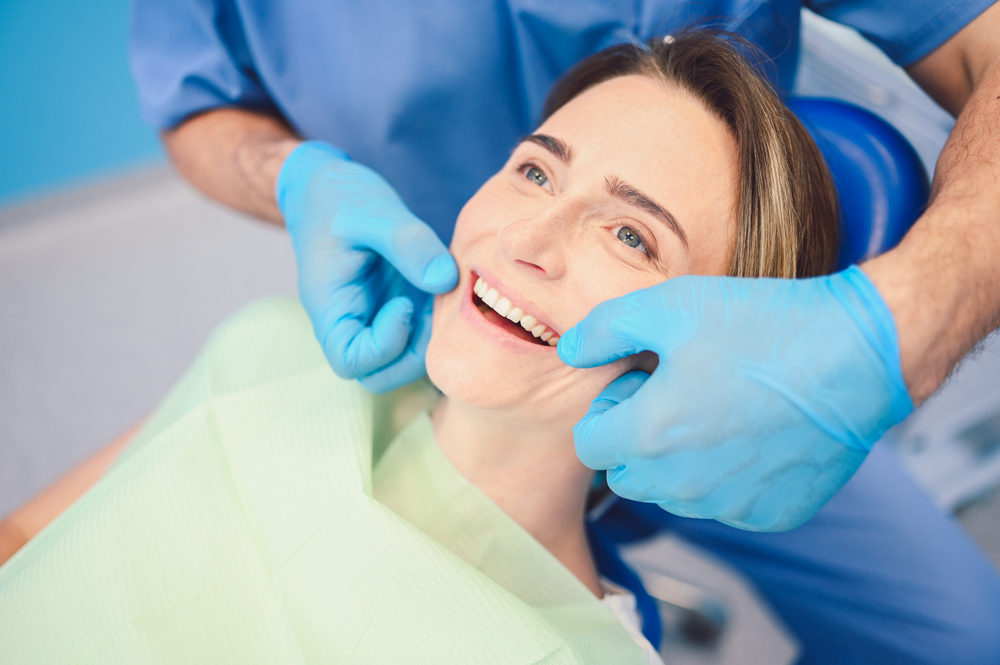If you’ve been diagnosed with bruxism, you know that it can cause sore jaw muscles or TMJ pain. But you might be surprised to know that bruxism — also known as teeth grinding or clenching — can also affect the look of your jaw. Can teeth grinding change your face shape? Simply put, yes, teeth grinding can make your jawline more square-looking, an aesthetic quality that some are fine with while others would prefer to change.
If the latter sounds like you, you’ll be happy to know that your Henderson, NV orthodontist, Dr. Okuda, is an expert in both relieving bruxism and addressing the changes it makes in your jawline contours. Let’s talk about what you need to know about bruxism and your face shape so you can make an informed choice about which treatment to choose.
We’ll cover:
-
- How does grinding your teeth change your face shape?
- How teeth grinding is treated
- Orthodontic treatments that can help with bruxism and face shape
- How BOTOX® is used for jaw slimming
- What does the process of BOTOX in the jaw look like?
How Does Grinding Your Teeth Change Your Face Shape?
Feel the sides of your face just by your earlobes. When you bite your teeth together, chew, or grind your teeth, you activate these jaw muscles and you can feel them bulge out while they work. They give you the muscle power you need to open and close your jaw.
Also called “masseter muscles” these jaw muscles — along with your jaw joints — are tremendously affected when you have bruxism. A chronic habit of teeth grinding and jaw clenching works your masseter muscles extra hard. And just like any muscle in your body that gets worked out (or overworked) consistently, masseter muscles can bulk up over time.
Sometimes you won’t see much of a difference in your jawline from bruxism; on first glance, your lower face might not have changed much. It’s true that the hefty teeth grinding and clenching from bruxism sometimes doesn’t enlarge your muscles enough to change your face shape.
Other times, bruxism can visibly alter your jawline. A noticeable difference can depend on a few things: how severe is your bruxism? What is your original jawline shape — like how narrow or wide is your lower face naturally? How aligned is your bite?
Can you change your jawline from the effects of bruxism on your masseter muscles? Well, preventing the jaw muscles from getting bigger can be hard when you have a chronic habit of grinding or clenching your teeth. Especially because bruxism is involuntary — and usually happens at night when you’re sleeping and don’t notice you’re doing it. But if you can treat your teeth-grinding habit, you can at least lessen the impact of bruxism on your jawline.
How Teeth Grinding is Treated
Treatment for teeth grinding is often the first step in giving your masseter muscles a break. And treatment for teeth grinding and clenching also addresses TMJ pain if you also suffer from that, too.
Prescribing A Mouthguard
At Okuda Orthodontics, Dr. Okuda is an expert in treating bruxism and we have several options which we personalize to your situation. One typical treatment is a special mouthguard you place over your teeth during the times you grind them. You wear a mouthguard at night if that’s when your grind or clench your teeth, or, less common, during the day if that’s when your bruxism is most active.
A mouthguard helps:
-
- absorbs the force of grinding or clenching your teeth
- lessens the stress on your jaw joints and masseter muscles
- gives your jaw joints and muscles time to heal
- helps prevent further damage to teeth
- aids in changing your bruxism behavior
You don’t typically have to wear a mouthguard forever — Dr. Okuda will determine a plan that alleviates your bruxism and at the same time encourages new, teeth-friendly habits.
Orthodontic Treatments that Can Help With Bruxism and Face Shape
Having straight teeth and a well-aligned bite go a long way in preventing the bruxism habits that can change your face shape. When teeth are crooked or top and bottom arches don’t stack together well, some people grind their teeth in a subconscious attempt to rest their teeth together properly.

Orthodontic treatment like the Damon® braces or Invisalign® we offer at Okuda Orthodontics brings teeth into alignment. They also can help address the teeth grinding that can alter your face shape. But we don’t just look at your teeth. At Okuda Orthodontics, we consider your whole facial structure. We design dream smiles that complement our patients’ unique facial features as well as contribute to healthy oral functioning overall: a straight smile means you’re less susceptible to tooth decay, cavities and gum disease.
Braces and Invisalign can also interrupt or prevent the extra wear and tear on your teeth that can happen from bruxism. Severe teeth grinding and clenching can affect face shape by changing the integrity of your teeth, wearing down the protective enamel so your teeth are more susceptible to tooth decay. And in cases of severe tooth decay or gum disease, sometimes teeth fall out or require removal. Missing teeth can change your face shape, caving it in our causing asymmetry.
How Botox® is Used for Jaw Slimming
Botox for your jawline? Yes, this cosmetic injectable treatment isn’t just for celebrities looking to maintain a youthful appearance. It’s widely available and used as a non-surgical, non-invasive treatment for lines, wrinkles, pain and jawline slimming. In fact, it’s the #1 non-invasive procedure of 2022 in the US and over 7.4 million people are currently receiving BOTOX. Not surprising since BOTOX is quick, safe, virtually painless, and has lasting effects.
Who Can Administer BOTOX?
Doctors, dentists (and dental specialists like orthodontists), plus some nurse practitioners can administer BOTOX if certified. Dr. Okuda is one such healthcare provider: as a certified BOTOX provider in Las Vegas, Dr. Okuda offers BOTOX for both cosmetic and therapeutic reasons.
As a therapeutic treatment, we at Okuda Orthodontics have seen how BOTOX can help alleviate chronic muscle tension and pain in the jaw, which is what makes it a great option for jaw issues like teeth grinding, clenching, and TMJ disorder. We’ve also seen how BOTOX treatments improve facial concerns like a gummy smile, wrinkles, lines, and the effects of bruxism on face shape.
How BOTOX Works in the Jaw
This is how BOTOX works as a jaw slimming treatment: a series of targeted BOTOX jaw injections are administered into the masseter muscles, temporarily blocking the nerve signals from your jaw muscles to your brain. Now, we understand this might sounds scary, but rest assured, BOTOX in your jaw is safe and doesn’t have long-term negative side effects on your muscles.
What it does do, however, is interrupt the impact of jaw clenching and teeth grinding — the jaw muscles don’t contract and get overworked from bruxism. Over time, the relaxed jaw muscles lose their enlarged muscle mass and atrophy, returning to their natural, slimmer jaw shape.
Can I Continue On As Normal With Jaw BOTOX?
Now, a common question our jaw BOTOX patients ask is, “Does BOTOX treatment in my jaw affect the ability to use my lower jaw?” You’ll be happy to know that jaw BOTOX doesn’t impede the use of your jaw when injected properly by a certified, experienced BOTOX provider like Dr. Okuda. The opposite, actually! You might enjoy chewing, biting, smiling and talking more than you did before because you have less jaw pain. You might even experience fewer headaches, migraines or neck tension with BOTOX, too.
What Does the Process of BOTOX in the Jaw Look Like?
As mentioned, jaw BOTOX is a series of BOTOX injections that help relax and shrink the masseter muscles over time for jaw slimming results. Since BOTOX works as a targeted treatment, Dr. Okuda injects BOTOX directly into your overworked masseter muscles at short, 15-minute sessions.
We guess you already know that a single BOTOX session won’t likely make a dramatic change to your face shape immediately. And it won’t instantly stop your bruxism habit that’s enlarged your jawline in the first place. You’ll find that it takes a couple of weeks for the full effects of BOTOX to kick in. Depending on your progress and Dr. Okuda’s recommendations, you’ll likely see Dr. Okuda for several sessions. It lasts about 3-4 months and is a gradual process, giving your massetar muscles the time they need to relax, heal, and shrink back to normal.
The number of BOTOX jaw injections and the time it takes for face slimming depends on a few things:
-
- The extent of your bruxism
- How much the jaw muscles have grown
- Your original face shape
- Your age
- Daily diet habits
A great perk of BOTOX as a jaw slimming treatment is that if you have other facial concerns like lines or wrinkles, you can treat them concurrently. You don’t have to wait for your jaw BOTOX treatment to complete before starting other BOTOX or filler treatments. Pretty efficient if you ask us!
Jaw Slimming Treatment With Your Henderson, NV Orthodontist
Now that you know all about how teeth grinding can change your face shape and what can be done to reverse it, visit your Las Vegas-area orthodontist to find out more. As an expert in facial anatomy and functioning, Dr. Okuda is a trusted option for BOTOX that yields results.
Contact us today to find out how Okuda Orthodontics can help you address your bruxism and get you back to a more confident face shape.


